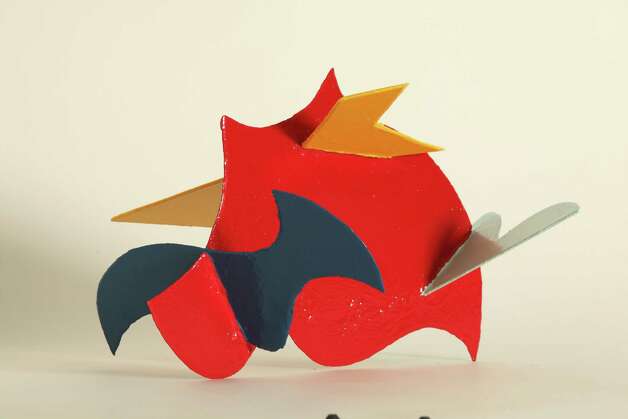How many times have you heard that statement uttered in front of a piece of modern or contemporary sculpture? Or blurted it yourself?
Robbin Zella, director of the Housatonic Museum of Art at Housatonic Community College in Bridgeport, said viewing modern sculpture doesn't need to be such a difficult endeavor, as long as the viewer is open to having a "conversation" with the piece. Sounds easy enough, but is it possible for the "average Joe/Jane" to do?

Now through Feb. 8, the playful biomorphic and geometric art of the late Connecticut sculptor David Hayes is being celebrated at the Housatonic Museum of Art, in Bridgeport, with an exhibit, "Modern Master of American Abstraction." Above is an example of his work. Photo: Contributed Photo
"Yes," said Zella, who oversees a multimillion-dollar collection that includes a sizable portfolio of modern art from the 1860s to the 1970s.
Viewing modern art is "like going to a dance," she said. "If you want to be a wallflower and sit alone in a corner, that's your choice. But if you want to get the most out of the experience, you need the right attitude and a willingness to get involved. Same with art."
As with any form of artistic expression -- whether it be literature, music or art -- it's nearly impossible to gain a deep appreciation for a work based on a cursory or one-time exposure. One needs to be a willing participant in the process, she said. So Zella suggests "slowing down, and remembering that sculpture is three-dimensional, which means that you need to move around it and see it from various angles and perspectives.
"It's important to keep in mind that the elements of design -- as with clothing and furniture -- apply," she said. "Look for line, shape, color, composition and material -- and how all of it is executed."
Granted, some works are more difficult to comprehend than others, but "as long as you approach it with a sense of curiosity and a willingness to engage in conversation with the piece, you will have a point of departure" for future exploration, Zella said.
Or just let your imagination run wild, as the late Connecticut sculptor David Hayes suggested that viewers do when contemplating his pieces.
Hayes is the subject of a new exhibit, "David Hayes: Modern Master of American Abstraction" at HMA's Burt Chernow Galleries. Known for his huge biomorphic and geometric welded sculptures, Hayes painted and sculpted until his death on April 9, 2013. The Housatonic exhibition features drawings and maquettes that were created as studies for Hayes' monumental sculptures at his Coventry studio and estate, where dozens of his sculptures are situated on 50-plus acres of farmland and woodlands. Zella said the influence of his mentor David Smith and his friend, Connecticut legend Alexander Calder, are visible in the two playful welded steel polychrome works on view at the HMA.
To fully appreciate any period in art history, Zella continued, it helps to put the era in context. For example, the French Impressionists, who were the early Modernists, not only painted what we now consider to be "pretty" pictures, they painted revolutionary ones: before the 1860s, the idea of painting everyday people in everyday situations, often outdoors, was considered unconventional (and sometimes called "crude") by the art world.
Later, the Modernists in Paris were considered "degenerate" by the Nazis. Even so, under Adolf Hitler's orders, much of the art was confiscated. Many artists fled and -- with Europe in shambles during World War II -- New York came to supplant the City of Light as the nexus of the art world, becoming fertile ground for the Abstract Expressionist movement. And central to that New York circle was Smith, Hayes' mentor.
Hayes may have been influenced by Smith (and eventually Calder), but as he matured as an artist, his work became distinctively his own, drawing inspiration from nature, at times "translating delicate foliage into lyrical, brightly painted industrial-strength sculptures," Zella said.
"He truly was a modern master. In his gouaches, there is a precision and sureness that reflects an artist at the top of his game," she said. "If I could characterize our show, I would say `exuberant.' There is a liveliness to his work, even a whimsy at times ... a great `joie de vivre' that can make you smile. It's a joyful show."
Housatonic Museum of Art, 900 Lafayette Blvd., Bridgeport. Monday through Friday, 8:30 a.m. to 5:30 p.m; Thursday to 7 p.m.; Saturdays 9 a.m. to 3 p.m.; Sundays, noon to 4 p.m.; closed Dec. 25-26 and Jan. 1-2. Through Feb. 8. 203-332-5052;
fonte: @edisonmariotti #edisonmariotti www.hcc.commnet.edu/artmuseum/


Nenhum comentário:
Postar um comentário